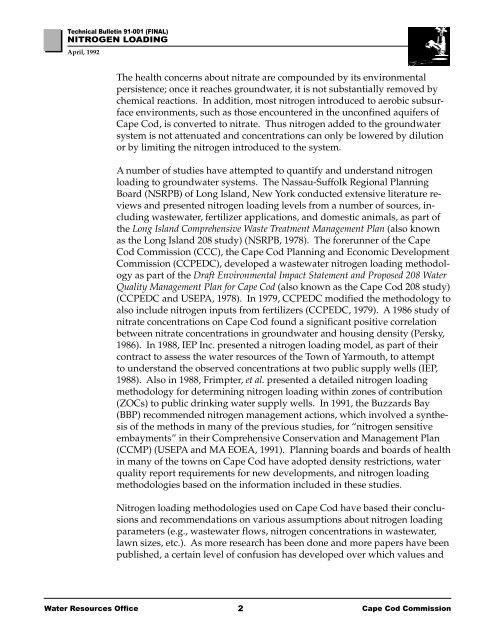Technical Bulletin 91-001 Nitrogen Loading - Cape Cod Commission
Technical Bulletin 91-001 Nitrogen Loading - Cape Cod Commission
Technical Bulletin 91-001 Nitrogen Loading - Cape Cod Commission
You also want an ePaper? Increase the reach of your titles
YUMPU automatically turns print PDFs into web optimized ePapers that Google loves.
<strong>Technical</strong> <strong>Bulletin</strong> <strong>91</strong>-<strong>001</strong> (FINAL)<br />
NITROGEN LOADING<br />
April, 1992<br />
The health concerns about nitrate are compounded by its environmental<br />
persistence; once it reaches groundwater, it is not substantially removed by<br />
chemical reactions. In addition, most nitrogen introduced to aerobic subsurface<br />
environments, such as those encountered in the unconfined aquifers of<br />
<strong>Cape</strong> <strong>Cod</strong>, is converted to nitrate. Thus nitrogen added to the groundwater<br />
system is not attenuated and concentrations can only be lowered by dilution<br />
or by limiting the nitrogen introduced to the system.<br />
A number of studies have attempted to quantify and understand nitrogen<br />
loading to groundwater systems. The Nassau-Suffolk Regional Planning<br />
Board (NSRPB) of Long Island, New York conducted extensive literature reviews<br />
and presented nitrogen loading levels from a number of sources, including<br />
wastewater, fertilizer applications, and domestic animals, as part of<br />
the Long Island Comprehensive Waste Treatment Management Plan (also known<br />
as the Long Island 208 study) (NSRPB, 1978). The forerunner of the <strong>Cape</strong><br />
<strong>Cod</strong> <strong>Commission</strong> (CCC), the <strong>Cape</strong> <strong>Cod</strong> Planning and Economic Development<br />
<strong>Commission</strong> (CCPEDC), developed a wastewater nitrogen loading methodology<br />
as part of the Draft Environmental Impact Statement and Proposed 208 Water<br />
Quality Management Plan for <strong>Cape</strong> <strong>Cod</strong> (also known as the <strong>Cape</strong> <strong>Cod</strong> 208 study)<br />
(CCPEDC and USEPA, 1978). In 1979, CCPEDC modified the methodology to<br />
also include nitrogen inputs from fertilizers (CCPEDC, 1979). A 1986 study of<br />
nitrate concentrations on <strong>Cape</strong> <strong>Cod</strong> found a significant positive correlation<br />
between nitrate concentrations in groundwater and housing density (Persky,<br />
1986). In 1988, IEP Inc. presented a nitrogen loading model, as part of their<br />
contract to assess the water resources of the Town of Yarmouth, to attempt<br />
to understand the observed concentrations at two public supply wells (IEP,<br />
1988). Also in 1988, Frimpter, et al. presented a detailed nitrogen loading<br />
methodology for determining nitrogen loading within zones of contribution<br />
(ZOCs) to public drinking water supply wells. In 19<strong>91</strong>, the Buzzards Bay<br />
(BBP) recommended nitrogen management actions, which involved a synthesis<br />
of the methods in many of the previous studies, for “nitrogen sensitive<br />
embayments” in their Comprehensive Conservation and Management Plan<br />
(CCMP) (USEPA and MA EOEA, 19<strong>91</strong>). Planning boards and boards of health<br />
in many of the towns on <strong>Cape</strong> <strong>Cod</strong> have adopted density restrictions, water<br />
quality report requirements for new developments, and nitrogen loading<br />
methodologies based on the information included in these studies.<br />
<strong>Nitrogen</strong> loading methodologies used on <strong>Cape</strong> <strong>Cod</strong> have based their conclusions<br />
and recommendations on various assumptions about nitrogen loading<br />
parameters (e.g., wastewater flows, nitrogen concentrations in wastewater,<br />
lawn sizes, etc.). As more research has been done and more papers have been<br />
published, a certain level of confusion has developed over which values and<br />
Water Resources Office 2<br />
<strong>Cape</strong> <strong>Cod</strong> <strong>Commission</strong>
















